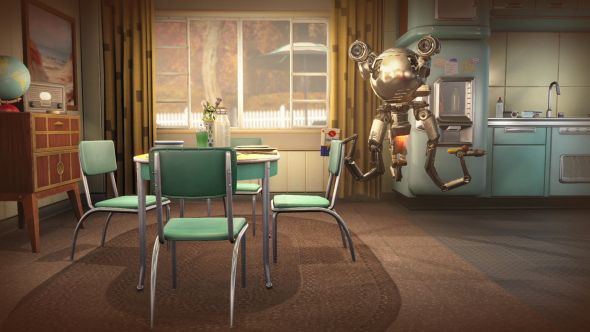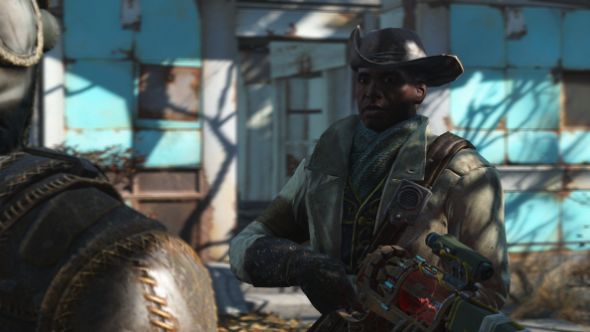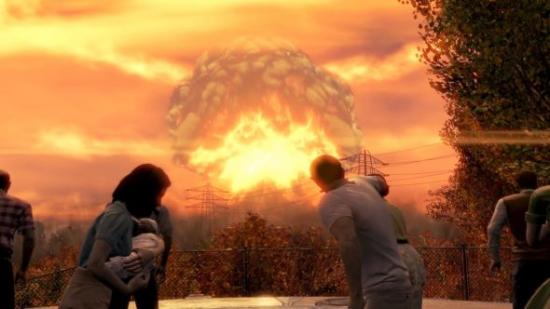It’s a Saturday morning in October. You get up, shave, and answer the front door of your spotless model home. There, a Willy Loman-style salesman preaches peace of mind. He soon sells you on a spot into the local fallout shelter.
Related: the best ever RPGs.
Minutes later, you’re sprinting past the picket fences with your spouse and baby to take full advantage of your new purchase – leaving the same salesman languishing outside as the bombs drop.
It’s a piece in perfect keeping with the grim irony of the Fallout universe, and a cracking bit of cinema from a studio with no reputation for scripted sequences. What’s more, it made for a really great E3 presentation last year – one in which Todd Howard proclaimed that the world before the bombs was “one of the great things about Fallout”.
Nonetheless, Fallout 4 was wrong to take us there in the intro. By doing so, they gave the Sole Survivor two personalities: one, a parent on a desperate hunt for answers. And the other, a self-expressive lump of clay, slowly fashioned into a person by Fallout’s freeform character creation and roleplay. As the game rolls on, that first personality diminishes but never quite goes away – jarring uncomfortably with the human being you’ve built yourself.
I can’t rid myself of that idea now – and Bethesda first planted the seed.
On the misty island of Fallout’s Far Harbor DLC, there’s an enclave where the synths go. These were people who started to get an uncanny sense that their memories were not their own, and wound up at this mountaintop refuge above the fog. A place of clarity and self-discovery.
There the player meets DiMA – a cast-out Institute prototype who resembles companion character Nick Valentine, minus the trenchcoat and fedora.
“Tell me,” DiMA asks, “Are you a synth?”
It’s a fun line of questioning, but not one that any seasoned player is inclined to take seriously. I mean, you’d know, wouldn’t you? After tens of hours spent in the Commonwealth, some with the acute radiation sickness that doesn’t bother Nick?
But then DiMA presses for more: “What’s the first memory you have?”

As always, you have a few options. You can tell DiMA about the family in the model home. You can tell him, justifiably, to bog off and mind his own business. But there’s really only one answer you can give truthfully: “The day the bombs fell”.
It’s a neat bit of meta-commentary. As players, all we ever do is accept the implanted memories of a given game’s protagonist and walk around wearing their face. Sometimes, maybe, you try to feel as they would. In Fallout 4, you might mimic the behaviour and perspective of somebody who’s suffered a terrible trauma and lost their child. But the tangible memories you have are the ones that coalesce over hours spent with the game.
How many of those 100 hours in vanilla Fallout 4 were passed pondering the Sole Survivor’s backstory? And how many more carving their story for them? That’s where the dissonance lies, and it gets more dissonant with every action you complete in the game because you’re telling the world – and yourself – what sort of person this is. Chances are, they’ve diverged starkly from the stranger in the prologue. Become somebody who would never have had that nuclear family in suburbia in the first place.
Episode four of HBO’s Westworld is called ‘Dissonance Theory’. It refers to a real cognitive phenomenon that sees people struggle to hold two conflicting beliefs in their head, and go to great lengths to resolve that conflict. It’s the stress experienced by the synths in Westworld’s park, who are beginning to wake up to two clashing realities. And it’s something like the internal battle that can rage while attempting to roleplay Fallout’s Sole Survivor.
Fallout 4’s backstory has a lot going for it. It grounds the character in a relatable pre-war world, not too different from ours. It gives the player a connection with companions like Nick, whose own implanted memories come from a pre-war police detective. And it provides a backbone to the cross-Commonwealth main quest, arguably the best in Bethesda’s history. But it’s so specific, and so divergent from the character the player gradually builds themselves in the wasteland, that the dissonance becomes impossible to resolve.
RPGs in the olden days had a hokey solution for this very problem: amnesia. Planescape: Torment, Baldur’s Gate II, Knights of the Old Republic, The Witcher – all gave their protagonists this highly convenient affliction. It allowed the player to start exactly where the character was: new to the world, a babe born at 25 years old with a muscular physique and a predisposition towards weapons training.

Even Bethesda had their own take. Ever wondered why Elder Scrolls protagonists are always prisoners given a ‘fresh start’? Their pasts don’t matter. Their memories are bound to another place.
Silly as the amnesia solution was, by the ‘00s, it was starting to get clever. KOTOR built a central twist around it. The Witcher series turned it into the catalyst for an accidental love triangle. Even now, in Wild Hunt, it’s the source of in-jokes and some excruciatingly embarrassing scenes with Yennefer and Triss.
Perhaps it should be brought back. Explored further. Made more subtle. It’s wonderful that protagonists have become more elaborate, with ambitious parent-child stories and fixed-but-malleable personalities like Commander Shepard. But for the RPGs that still promise an identity sculpted from scratch in the bathroom mirror, the least they could do is not put ideas in our heads.
